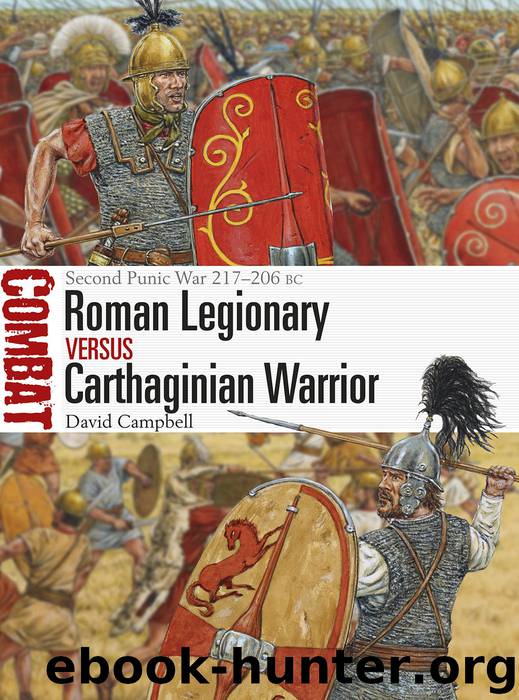Roman Legionary vs Carthaginian Warrior by David Campbell

Author:David Campbell
Language: eng
Format: epub
ISBN: 9781472828057
Publisher: Bloomsbury Publishing
Published: 2018-04-29T00:00:00+00:00
A bronze torso (Hellenistic or imperial, 2nd century BC–2nd century AD). Originally part of an equestrian statue, the figure wears a cuirass of linothorax-type design, this one with pteruges (strips of protective leather) at the shoulder. It is a good example of the sort of highly decorated distinctive personal armour that would be worn by senior officers of either Roman or Carthaginian armies during this period. (Metropolitan Museum of Art, www.metmuseum.org)
News of Hannibal’s move spurred Paullus and Varro, who quickly readied their new forces and left Rome, probably in late June, heading south-east to liaise with Atilius and Servilius, who had been gingerly shadowing the progress of Hannibal ever since he had vacated his winter quarters. Though the accounts of Livy and Polybius are clear that the consuls did not get along (and they each share a particularly dim view of Varro), both consuls must have considered the kind of strategy they would need to employ if they were to fulfil the wishes of the Roman people. The army they had at their disposal was the largest that Rome had ever fielded, but it had several shortcomings. It lacked experienced men, so many having been killed or fallen into captivity in the past 18 months. Moreover, the new recruits would likely have been levied from a broader base than was usual, perhaps with the suspension of the property qualification allowing many more men to become eligible for service (Healy 1994: 65), but they might not have the same level of military skill that many propertied recruits would already have attained before they even joined their legion. The new consuls were only elected in March, meaning that the legions they were raising had almost no time at all to train; this may have meant that standard legionary manoeuvres were too complex to perform for such callow troops, especially in the face of the enemy. The cavalry requirement from the alae had been doubled, but that still left a wide gap between the Roman and Carthaginian numbers, not to mention the fact that the Carthaginian force was proven and battle-hardened, which was the case with maybe only one-third of the Roman army’s horsemen. Such factors must have been clear to both Roman commanders, and must in turn have influenced their decisions with regard to the eventual deployment of their army. Nevertheless they both seem to have lacked Hannibal’s sense of strategic initiative, his appreciation of the fact that the easiest way to win a battle was to do it before one ever took to the battlefield. The decision of where and how to fight would be Hannibal’s, not theirs.
Download
This site does not store any files on its server. We only index and link to content provided by other sites. Please contact the content providers to delete copyright contents if any and email us, we'll remove relevant links or contents immediately.
| Africa | Americas |
| Arctic & Antarctica | Asia |
| Australia & Oceania | Europe |
| Middle East | Russia |
| United States | World |
| Ancient Civilizations | Military |
| Historical Study & Educational Resources |
The Travels of Reverend Ólafur Egilsson: The Story of the Barbary Corsair Raid on Iceland in 1627 by Ólafur Egilsson & Karl Smári Hreinsson(594)
Pirates of Barbary: Corsairs, Conquests and Captivity in the Seventeenth-Century Mediterranean by Adrian Tinniswood(527)
Phantom Major by Virginia Cowles(398)
The Iberian World by Fernando Bouza;Pedro Cardim;Antonio Feros;(380)
The Battle for North Africa by Glyn Harper(363)
The Animal in Ottoman Egypt by Alan Mikhail(362)
Roman Legionary vs Carthaginian Warrior by David Campbell(355)
Eritrea at a Crossroads by Andebrhan Welde Giorgis(333)
Collapse of a Country: A Diplomat's Memoir of South Sudan by Nicholas Coghlan(330)
The Barbary Wars by Frank Lambert(330)
The End of Barbary Terror: America's 1815 War against the Pirates of North Africa by Frederick C. Leiner(307)
Christianity in Roman Africa by Burns J. Patout Jr.; Jensen Robin M.; & Robin M. Jensen(306)
The Sands of Kalahari by William Mulvihill(287)
A History of the Mediterranean Air War 1940–1945 by Christopher Shores(280)
Morocco by C. R. Pennell(271)
A Line in the River by Jamal Mahjoub(250)
The Holocaust and North Africa by Aomar Boum Sarah Abrevaya Stein(246)
The Making of a Mediterranean Emirate by Rouighi Ramzi;(245)
A History of South Sudan by Rolandsen Øystein H. & Daly M. W. & Rolandsen Øystein H. & Daly M. W(242)
